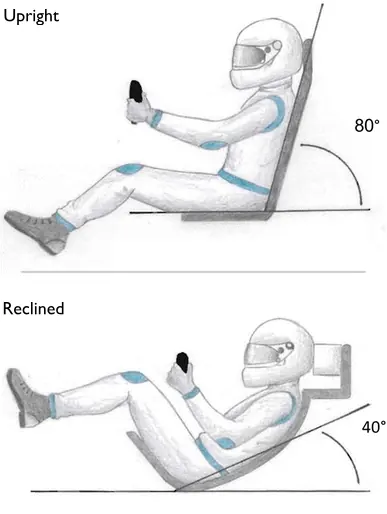Driving / Technique
Race car driving – even sim racing – is a physical sport that requires strength and precision. The feedback forces through the steering wheel are generally quite high so as to provide as much information as possible about the grip of the front tires, and the brake pressures required are also typically high in order to allow for the widest range of pressure variability.
As such, as with any sport, one’s foundational body position must be athletic and well-tuned to the specific size and shape of the athlete.
Seat
There are two basic seating positions a race car may have: an upright position derived from road cars and a reclined position specific to purpose-built racing machines.

Upright Seating
An upright seating position is generally found in rally race cars and road race cars derived from everyday road cars. Rally drivers sit upright for improved visibility of the track surface whereas some road race cars have drivers sit upright as they are not allowed to modify the fundamental structure of the road car from which they are derived as per the rules of the racing series in which they participate.
This type of seating position is characterized by an upright seating posture and feet that rest much lower than the driver’s hips, like a standard road car.
The primary issue with this seating position lies in the fact that the lower the brake pedal is relative to the driver’s hips, the more vertical force will push the driver up and out of the seat as they press into the brake pedal, limiting the maximum brake pressure that can be applied.
A properly heavy brake pedal will require essentially as much leg force as a driver can apply, meaning pedals that sit below the hips of the driver can easily result in the driver lifting themselves up off the seat unless more braking assistance is used, reducing the fidelity of the driver’s braking inputs. A driver’s safety belts can help hold them down in the seat to some degree, but safety belts are not designed to hold a driver down as constant pressure on one’s shoulders would quickly result in bruising and fatigue.
IRL: Additionally, more upright seating positions place the mass of the driver higher within the vehicle, hurting vehicle performance. One universal area of performance in any racing vehicle is lowering the center of mass as much as possible.
Reclined Seating
A reclined seating position is characterized by feet that rest above the hips of the driver and is ideal for racing for multiple reasons.
The primary benefit of feet and pedals that are at or above the driver’s hip line is the ability to apply greater brake pressure without pushing the driver’s body up out of the seat or flexing the seat back. If anything, braking while in such a seating position helps push the driver’s body down into the seat, ensuring they are stable and locked in while their body is otherwise being pushed out of the seat from the braking forces.
Note that a seat designed for upright use cannot simply be leaned back in order to provide a reclined seating position. In such a case, the head and shoulders will not be oriented properly and it will be impossible to keep one’s head and shoulders vertical.
Also note that seating positions can lie anywhere in between these two extremes as not every vehicle is capable of containing a driver in a heavily reclined seating position.
Pedals
A driver’s knees should maintain a slight bend when pedals are fully pressed.
When not pressed, a driver’s ankles should be relaxed. One does not want to have to engage one’s tibialis muscles in order to keep pressure off the pedals. This is done via a combination of pedal distance and pedal angle, however not all pedals can be adjusted for angle.
In general, pedals should be as high as they can be without the driver feeling uncomfortable; if a driver has to stretch their hamstrings, the pedals are too high.
Steering Wheel
The steering wheel should be close enough to the chest that a driver’s arms have approximately a 90° bend, with a tighter angle being even better.
The goal is to keep one’s shoulders back against the seat and to keep one’s hands close enough to the body that the major forces from the steering feedback go through one’s chest and not one’s shoulders.
The height and angle of the steering wheel are personal preference. Wheel height is usually around one’s chest to upper chest; it is usually fined tuned based on the visibility of the driver (road, gauges) and cockpit adjustment limitations.
The more reclined one’s seating position, the more horizontal the wheel will likely be, and vice versa; the more vertical one’s seating position the more angle the wheel will likely have in order to feel comfortable.